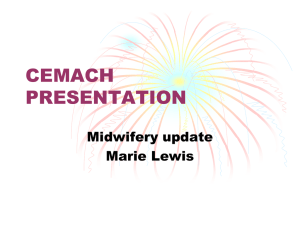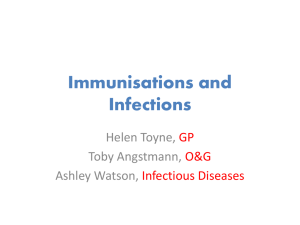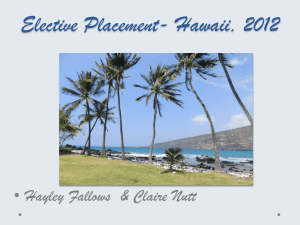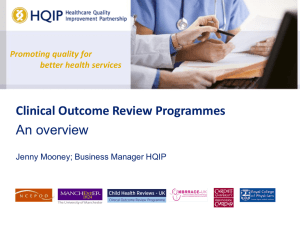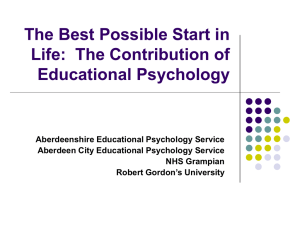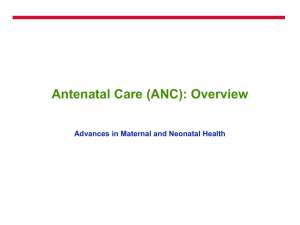09. Universal lessons for care Dec 2014
advertisement
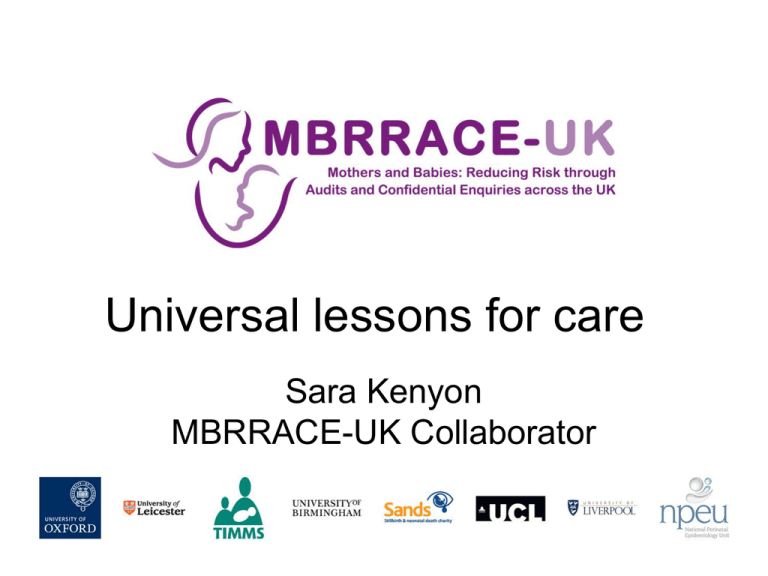
Universal lessons for care Sara Kenyon MBRRACE-UK Collaborator Background • Maternal deaths have decreased, but there are still lessons we can learn • Two thirds of women die from medical and mental health problems and one third from direct complications of pregnancy • Three quarters of the women who died had medical or mental health problems before they become pregnant Universal lessons This highlights the importance of • history taking at booking and • recognition and referral when necessary Access to antenatal care Almost 11% of women did not receive any antenatal care, however, five of the 35 women died in early pregnancy (≤10 weeks) Only 29% of women who had antenatal care received the recommended level of care according to NICE antenatal care guidelines (booking at 10 weeks or less and no routine antenatal visits missed) Almost two thirds received a minimum level of antenatal care (booking at less than 13 weeks and three or fewer antenatal visits missed); 25% did not receive even this minimum level of care We must continue our efforts to engage women High risk groups • Maternal mortality rates were higher amongst older women, women living in the most deprived areas and women from some ethnic minority groups (Asia and Africa) • Women born outside the UK were significantly more likely to die than those born in the UK We must continue our efforts to engage these high risk women Co-existing medical complications • Nearly three quarters of women who died had a coexisting medical complication • There has been no significant change in the rate of indirect maternal death of the last ten years, when the rate of deaths from direct causes has halved • The rate of indirect maternal deaths (6.87 per 100,000 maternities) is now twice that of direct deaths (3.25 per 100,000 maternities) Actions are urgently needed to address deaths from indirect causes Universal lessons Women with medical disorders in pregnancy should have access to a coordinated multidisciplinary obstetric and medical clinic, thereby avoiding the need to attend multiple appointments and poor communication between senior specialists responsible for their care, including in the preconceptual period Pregnant women with medical conditions require an individualised care plan made together by members of the multidisciplinary team including a midwife, obstetrician, obstetric anaesthetist, obstetric or specialty physician, surgeon and psychiatrist or members of the allied health professions as appropriate Universal lessons • There is a need to ensure physicians are appropriately trained • If your obstetric service currently does not offer joint care for women with identified needs with specialist physicians then you need to carefully consider either – Referring women to an existing service – Starting a service of your own Importance of observations • Do not presume normality; confirm it with a full set of clinical observations – Temperature, pulse, respirations and blood pressure • Record on a MEWS (or similar) chart • If abnormal refer to a more senior colleague Think Sepsis Signs and symptoms to watch out for • High temperature (over 38.30C) • Chills and shivering • Tachycardia • Breathlessness • Headache • Severe abdominal pain • Extreme sleepiness Vignette: sepsis Two hours after delivery a woman became unwell on the postnatal ward feeling faint. Her oxygen saturation was 65%. She was reviewed by junior staff and found to be shocked, with moderate PV bleeding. Her temperature was never measured. A diagnosis of haemorrhage was made and she was treated with fluids. She failed to improve and was taken to theatre where she had a cardiac arrest. A laparotomy and hysterectomy were carried out but resuscitation failed. The postmortem found an extensive blistering skin rash, swollen labia and disseminated intravascular coagulation all as a result of overwhelming Group A Streptococcal sepsis. Vignette; sepsis A woman who was seven days post spontaneous vaginal delivery became unwell at home with a fever. She was advised to attend the maternity unit immediately. On admission she was noted to be tachycardic, breathless and febrile. She was prioritised for urgent medical review. A diagnosis of acute sepsis from retained products was made and fluid resuscitation started immediately. Intravenous antibiotics were started within one hour of the diagnosis and she was transferred to the high dependency unit. The retained products of conception were removed promptly and she made a full recovery. Blood culture subsequently grew Klebsiella. Early recognition, clear advice and prompt treatment led to a good outcome without any further complications. Vignette; haemorrhage A woman had labour induced on the antenatal ward where she received uterotonic agents. She did not have observations done on arrival and subsequent observations were extremely limited, inadequate and infrequent (at best at 9 hourly intervals). This failure to record observations continued even when the woman’s condition was deteriorating and the woman was becoming increasingly distressed. A further uterotonic was administered without any recorded observations or examination. Staff handover was mentioned as a reason for the delay in attending to the woman who was becoming increasingly unwell. Her condition continued to deteriorate until she collapsed and had a cardiac arrest. She had a perimortem caesarean section on the antenatal ward where a large haemoperitoneum was discovered secondary to a uterine rupture. She had not had a previous caesarean section. Referral is important Physiological observations including the respiratory rate recorded within a trigger system such as the MEOWS chart should be used to monitor all antenatal and postnatal admissions. However, it is the response to the abnormal score that will affect outcome, not simply its documentation Vignette: referral A woman had an elective caesarean section with cumulative blood loss of 2000mls. She had a rising respiratory rate, a tachycardia and a falling blood pressure. There was no escalation of care despite very worrying and deteriorating observations. She was eventually found to have had a serious concealed haemorrhage and died Influenza • 1 in 11 of all women died from flu and more than half of these could have been prevented with a flu jab • Vaccination rates are generally around 25% if the only indication is pregnancy (Public Health England) • In the majority of women (94%) who presented with respiratory illness, influenza was not considered, even in the height in the H1N1 pandemic Vignette: influenza A pregnant woman presented to A&E and was admitted overnight with a cough, fever and breathlessness. All members of her family had an influenza-like illness. She was discharged home the next day with no relevant investigations performed and no antibiotic or antiviral treatment initiated. Her condition deteriorated and when reviewed by her GP the next day, emergency readmission was arranged. Testing for H1N1 was conducted which was positive and antiviral treatment commenced, however the woman rapidly deteriorated and died 3 days later. Universal lessons • The benefits of influenza vaccination to pregnant women should be promoted and pregnant women at any stage of pregnancy should be offered vaccination against seasonal and pandemic influenza with inactivated vaccine • Consider influenza as a possible diagnosis for women presenting with respiratory illness Epilepsy Common features of all deaths included: • Women of child bearing age were not given preconception counselling • Epilepsy nurses and other specialists were not available or used during pregnancy to help care for women with epilepsy Epilepsy • There was a delay in referring pregnant women with epilepsy or seizures to specialist services, or barriers to them accessing those services • Pregnant women with epilepsy were still not routinely identified as a high risk group (both in outpatient and inpatient settings), and appropriate precautions such as never placing them in single rooms were not always taken Universal lessons • Epilepsy remains a high risk condition in pregnancy and should continue to be managed as such in antenatal and postnatal care • Multi-agency evidence based operational guidance is urgently required to standardise and improve the care of pregnant women with epilepsy The care setting • There should be adequate provision of appropriate critical care support for the management of a pregnant woman who becomes unwell • All consultant led delivery suites must have access to level 2 high dependency unit facilities that are appropriately equipped and staffed by teams of senior obstetricians, anaesthetists and midwives, skilled in looking after seriously ill women especially those with sepsis Learning lessons to improve care We owe it to those left behind to learn from the death of their mother, partner, daughter or friend and to make changes for the future to prevent other women from dying Universal lessons • The deaths of all women should undergo multidisciplinary review at a local level • All staff should participate in the review of care for the Confidential Enquiry • Individual clinician’s perspectives on the care they have provided to women who die or have severe morbidity is invaluable to identify fully the lessons to be learned Multidisciplinary review Sepsis Deaths Maternal sepsis deaths n=83 Women with septic shock n=34 Internal review NOT undertaken 39 (47%) 22 (65%) Internal review undertaken 44( 53%) 12 (35%) • Obstetrician 28 (64%) 12 (100%) • Midwife 28 (64%) 5 (42%) • Anaesthetist 19 (43%) 2 (17%) • Other 23 (52%) 3 (25%) 2 (5%) 0 (0%) 17 (39%) 4 (33%) Staff involved in internal review: • External Root Cause analysis undertaken Universal lessons To increase the rigour of review • Consideration should be given to the develop a standardised toolkit for multidisciplinary review of maternal death in a Maternity Unit • Independent review should be part of the process Summary • Observations: – Confirm normality, do not presume it – Record and refer to more senior staff if required • Women with existing medical conditions should be seen by a multidisciplinary team • All maternal deaths should be reviewed Summary The focus of this 2009-12 report is on improving care; recommending changes or actions, small and large, that can be made to make care better for pregnant women across the UK. By learning from each and every maternal death, changes can be made to prevent pregnant women dying in the future. Thank you

